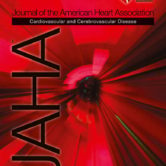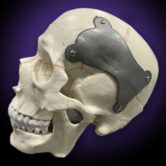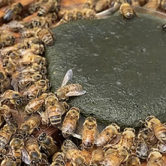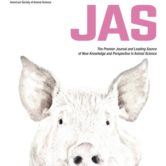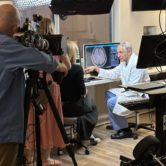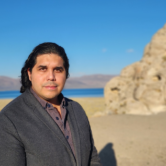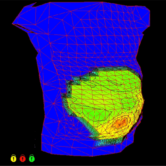Research Highlights
SOUTH CAROLINA: Clemson faculty member receives NSF CAREER Award
Former SC INBRE Developmental Research Project (DRP) Program grant recipient, Jordon Gilmore, Clemson University, has received an NSF CAREER Award. Gilmore's Award, titled “A Multi-phase Biosensing Approach towards Point-of-Care Evaluation of Pseudomonas aeruginosa Virulence in Infected Chronic Wounds” is follow-on research to his SC INBRE DRP award titled, “Point-of-Care Colorimetric Biosensor for Detection of Pseudomonas aeruginosa Signaling Molecule 3OC12HSL in Wound Exudate from Negative Pressure Wound Therapy.”
OKLAHOMA: NIH-funded study highlights importance of cholesterol screenings and education (featuring University of Oklahoma)
More than 70% of American Indian young adults aged 20-39 and 50% of American Indian teens have cholesterol levels(link is external) or elevated fat in the blood that put them at risk for cardiovascular disease, suggests a study supported by the NIH. The findings, published in the Journal of the American Heart Association, came from a 19-year-review of the Strong Heart Family Study, part of the Strong Heart Study — the largest study of cardiovascular health outcomes and risk factors among American Indian adults.
“We were surprised about the numbers, especially in adolescents,” said Jessica A. Reese, PhD, an epidemiologist in the Center for American Indian Health Research at the University of Oklahoma Health Sciences Center, Oklahoma City. “These findings show the importance of early screenings and interventions, especially for teens and young adults who may be more likely to have underlying cardiovascular risks, diabetes, or chronic liver disease.”
NEW HAMPSHIRE: NH NSF EPSCoR skull featured in NSF Multimedia Gallery
The NSF Multimedia Gallery recently featured “Skully,” a model of a human skull created by New Hampshire NSF EPSCoR NH BioMade researchers at the University of New Hampshire. Scientists there are researching metallic biomaterials and new techniques that can be used for trauma fixation applications, such as cranial implants for automobile accident victims or soldiers.
LOUISIANA: USDA Researchers Use an Edible Blue-Green Algae to Protect Honey Bees Against Viruses
Scientists at the USDA’s Agricultural Research Service (ARS) developed an edible antiviral treatment that can be used to protect honey bees against Deformed Wing Virus (DWV) and other viruses, according to a recent study published in Sustainable Agriculture.
“We found that engineered algae diets suppressed DWV infection and improved survival in honey bees,” said Vincent Ricigliano, research scientist at the ARS Honey Bee Laboratory in Baton Rouge, LA. “When mixed into bee food, the engineered algae boost the bee’s immune system to fight off the targeted virus.”
KANSAS: USDA study aims to find solutions for livestock well-being (feat. Kansas State University)
A collaborative effort between scientists from the USDA’s Agricultural Research Service, Texas Tech University, Kansas State University, and West Texas A&M University work on reliable and repeatable liver abscess models to learn the triggers for this costly condition in cattle that not only negatively impacts animal well-being but also causes liver condemnations and may lead to increased carcass trimming and an overall decrease in profitability.
The first successful model study, recently published in the Journal of Animal Science, is part of a series of studies conducted at the USDA-ARS Livestock Issues Research Unit in Lubbock, Texas, that aim to find solutions to a problem of concern for animal well-being that is costing the industry millions of dollars.
WEST VIRGINIA: West Virginia University advances in neuroscience featured on 60 Minutes
As a modern land-grant R1 university, one way that West Virginia University, an EPSCoR/IDeA institution, fulfills its purpose is through meaningful research that offers better health and greater prosperity for their state and beyond. They are transforming health care through innovation — and the nation is taking notice.
The WVU Rockefeller Neuroscience Institute (RNI) is advancing neuroscience and improving the lives of people with neurological and mental health conditions to address the most pressing challenges. The New England Journal of Medicine recently featured initial results utilizing focused ultrasound and antibody infusion resulting in the reduction of brain amyloid plaques for Alzheimer’s patients.
On Sunday, Jan 14, 60 Minutes aired a two-segment special featuring the work discussed in the NEJM and the never-before-released results of the RNI’s addiction efforts utilizing focused ultrasound.
IDAHO: Researcher receives Idaho NSF EPSCoR Research Award
A University of Idaho fire scientist is the recipient of the 2023 Jean’ne M. Shreeve Idaho NSF EPSCoR Research Excellence Award. Alistair Smith, professor and chair of the Department of Earth and Spatial Sciences, received the award during the Idaho EPSCoR Committee Annual Business Meeting held at Idaho State University in Pocatello.
Smith, an internationally recognized leader in wildland fire science, is an expert in pyroecophysiology, a new sub-field of fire ecology that he termed in 2017 that focuses on understanding how fires affect trees, why some die and, when they survive, what happens to them. His team’s research has had a major impact on changing the understanding of fire ecology, especially in the face of more intense and frequent fires under climate change.
NEVADA: INBRE Tribal Academy of Health and Science Coordinator featured in Nevada Today
In 2021, Nevada INBRE’s Andrew Tobey created the Nevada INBRE Tribal Academy of Health and Science to support Native American high school or college students through their education and career development in biomedical and health science fields. Through this program, students receive access to internship opportunities, academic help from science professionals, financial education, emotional development, learning about work/life balance, discussions about imposter syndrome and much more. Students and mentors meet weekly, providing a more personal connection through the program.
DELAWARE: INBRE researcher receives $300K award for eye research
Esther Biswas-Fiss, professor and chair of the Department of Medical and Molecular Sciences (MMSC), has received an Individual Investigator Research Award in the amount of $300,000 from the Foundation Fighting Blindness, a global leader in retinal degenerative disease research. Sam Biswas, professor of medical and molecular sciences, Barry Bodt, senior biostatistician in the College of Health Sciences, and Shawn Polson, associate professor of computer and information sciences and director of UD’s Bioinformatics Core Facility, are co-investigators on the project. The grant will support Biswas-Fiss’ research on the ABCA4 gene, which has over 3,000 genetic variants. The gene is the leading cause of Stargardt disease, an inherited retinal disease affecting one in 8,000 people worldwide, often resulting in blindness.
ARKANSAS: Clinical study suggests measuring uterine muscle activity could inform strategies for safer and faster childbirth (feat. UAMS)
Artificially causing – or inducing – labor is becoming increasingly common, yet this practice comes with risks and its level of success is difficult to foresee. But now, new research may offer a way to help predict outcomes and improve the process.
Researchers at the University of Arkansas for Medical Sciences (UAMS) have devised a non-invasive method of accurately measuring the electrical activity of uterine muscles. The results of a recent clinical study, published in the journal Current Research in Physiology, show that signals measured in pregnant patients prior to induction are strongly tied to whether their labor lasted less or more than 24 hours. The authors indicate that physicians could use the method to learn how patients might respond to induction and use the information to develop more effective strategies for labor and delivery.

